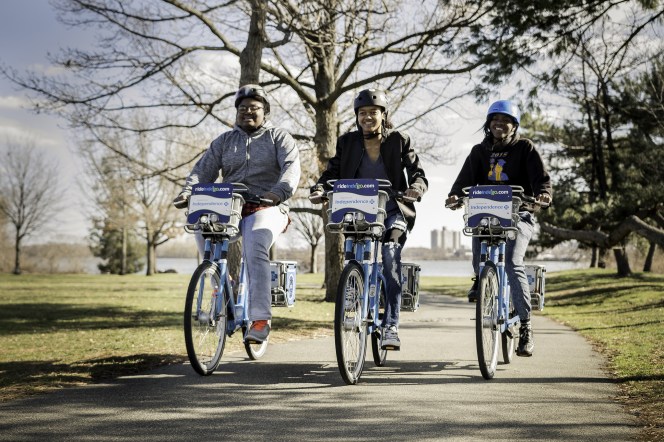Low-income communities and people of color view traffic risk, high prices, and the potential for crime and harassment as the biggest barriers to bicycling and using bike-share in their neighborhoods, according to a new report from researchers at Portland State University.
By surveying people who don't already use bike-share, the authors hope to get a better sense of what stands in the way of ridership. "Most of the studies of bike-share users in the past have been based on membership information, coming from the rolls of people who have already signed up," said Portland State research associate Nathan McNeil. "We wanted to talk with the people who weren’t already using bike-share."
Researchers got responses from 1,885 residents of specific neighborhoods in Philadelphia, Chicago, and Brooklyn. The analysis compared four demographics: lower-income people of color, higher-income people of color, lower-income white people, and higher-income white people.
The top barrier to bicycling in general was traffic safety, with 48 percent of all respondents citing it as a problem. Concern about dangerous traffic cut across demographic lines: 44 percent of low-income people of color cited it as a big barrier to riding a bike, as did 50 percent of high-income people of color, 53 percent of low-income whites, and 49 percent of high-income whites.
There was more variation when people were asked about barriers specific to bike-share. For low-income people of color, the most frequently cited obstacle was being on the hook "if anything happens to the bike." For all other groups, the biggest reason for not using bike-share was, "I just prefer to use my own bike."
Just four percent of survey respondents had tried their city's bike-share program. Within that, there were variations. Among all low-income residents, 2 percent had tried bike-share, compared to 5 percent of higher-income people of color and 10 percent of higher-income white people.
Although few respondents had used the bikes, there was widespread support for bike-share. Three quarters said they had seen people like them using the system and agreed that it "is useful for people like me," while 11 percent expected to join within the next 12 months -- results that didn't vary by race or income.
The survey did find that lower-income residents are more likely to see bike-share as a marker of gentrification -- 27 percent of lower-income people of color said bike-share "will make it more expensive to live in the neighborhood," nearly double the percentage of higher-income white residents. In addition, people of color were more likely than white respondents to have concerns about being a victim of crime or a target for police harassment when riding bike-share.
Often, people just haven't heard enough about bike-share to feel comfortable using it. This lack of familiarity is especially common among people of color and low-income residents, researchers found. “People that are unfamiliar with the system may not have a sense of how it could or would work," said McNeil. "Some of the misconceptions that, to us, are more significant, are not knowing about some of the discounts that are available."
Steps as simple as direct, face-to-face communication -- instead of relying on websites or kiosks -- can be very effective at getting the word out. Talking to someone at a bike-share outreach event made people more likely to use the system. “It was the more in-person types of interactions that appear to correlate with whether people are intending to use bike-share," McNeil said. His research team will soon be releasing another report that goes into more detail about outreach methods.
The researchers are writing a trio of reports on bike-share equity: a survey of bike-share operators was released in May [PDF], the survey of residents in areas with bike-share was released last week [PDF], and a survey of people who participated in programs aimed at encouraging bike-share use will be released later this summer.
The work is funded by the Better Bike Share Partnership, a collaboration between the City of Philadelphia, the Bicycle Coalition of Greater Philadelphia, the National Association of City Transportation Officials, and PeopleForBikes, a bike industry group. It's also supported through the National Institute for Transportation and Communities, a federal transportation center based at Portland State.






